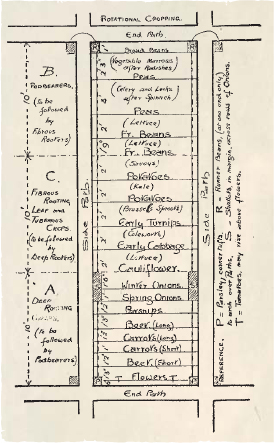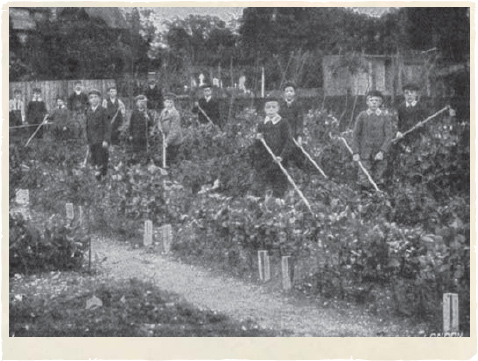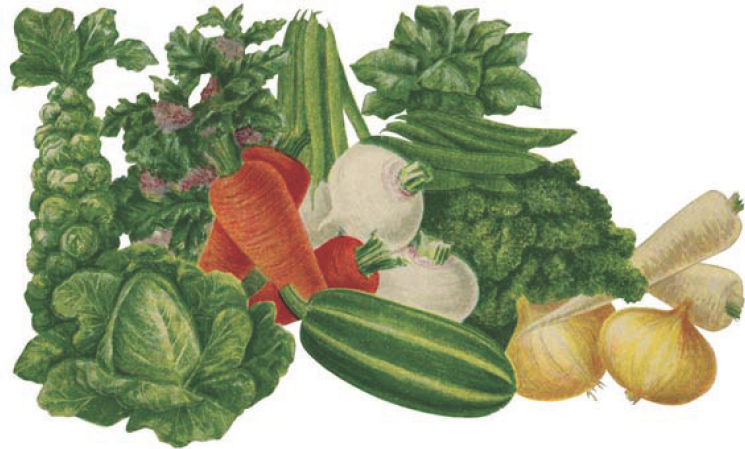 Cropping Garden-Allotments
Cropping Garden-Allotments 
 Cropping Garden-Allotments
Cropping Garden-Allotments 
 Vegetable Cropping
Vegetable Cropping 
In order that the greatest amount of sound information may be compressed into the smallest space, vegetables may, for purposes of cultivation, be arranged in three distinct groups:–
Group I. Bulbous and deep fleshy-rooted kinds.
Group II. Pod and fruit bearing kinds.
Group III. Fibrous-rooting leaf and early tuberous crops.
Why this grouping? The answer is: Because each group should if possible have a change of site every year for at least three years, and possibly more.
 Rotational Cropping
Rotational Cropping 
Take, say, a 10-rod allotment. For cropping purposes its length, where practicable, should be over thrice the width. All serviceable vegetables could be grown over the area in well-balanced proportions. A rational method of occupying the space would be to run a line through the centre and plant one long half with potatoes – one-third a few rows of first earlies, but still more second earlies, for summer and autumn use; the remaining two-thirds with late varieties for storing for use in winter and till ‘potatoes come again.’
The other long half would afford a full supply of all other useful crops, and might be advantageously arranged as indicated in the plan (opposite), which is one of many hundreds of boys’ instructional 1-rod plots in Surrey.

Garden plan adopted in Surrey School Gardens
 Intercropping
Intercropping 
Besides showing a sound method of ‘rotational’ cropping, or certain crops following others of different kinds with differing needs, the plan above also suggests examples of ‘intercropping’ or the growing of certain crops between others, not only without injury, but with advantage under good management.
Take an example with peas (for staking) as the main crop. There is much vacant space between the rows when these are at proper distances. They should be at the least 6 inches further apart than the peas grow in height. Exactly down the centre between the rows a line of spinach may be sown at the same time, and on each side of the spinach radish seed may be scattered thinly. The error to avoid is in leaving spare spinach or radishes to push up tall flower stems to exhaust the soil and exclude light and air from the peas. The point to remember is this: Never let any vegetables remain in the ground after they cease to be useful, as all they can do then is to deprive the soil of its virtues and give nothing in return. The spinach and radishes can in due course be followed by celery, leeks, or vegetable marrows.
Other examples of intercropping are seen on well-managed allotments. Dwarf early potatoes in rows 2 ½ feet apart can be intercropped with savoys, brussels sprouts, kale, and broccoli planted when large enough from seed sown in spring, as these crops do not require the whole of the ground till the potatoes are cleared away.
Vegetable marrow plants are often put in at intervals of 3 or 4 yards between potatoes, and spread over the ground, bearing good crops of fruit if the season is fine, after the potatoes are removed. All that is necessary is to start the plants with a spadeful or two of manure, and the potato tops will afford them shelter after planting at the end of May or early in June.
Profitable crops of scarlet runners can be had after dwarf early potatoes, the beans being dibbled between the potatoes in May, the rows of these being a yard apart. When the runners produce twiners they are chopped off with a sharp knife, and by continuing the practice from time to time the plants are converted into bushes, and bear abundantly. Scores of acres of scarlet runners are made dwarf in that way (not always between potatoes), and grown without sticks for affording tons of pods for market.
The time-honoured plan of dibbling a broad bean in here and there with potatoes, say at intervals of 4 or 5 yards, gives useful crops, stolen, so to say, from the ground, without the potatoes being appreciably injured; indeed, in wet seasons they are benefited rather than other-wise, the beans abstracting moisture which in excess is injurious to the tubers. When that is done a plot of ground need not be set apart for these beans by persons who desire to grow them.

Surrey School Gardens at Benhilton, Surrey
Another combination may be mentioned. Hardy cos and cabbage lettuce raised by sowing in the open, very thinly, in the first week in September, and the seedlings never allowed to touch each other, may pass through the winter. Planted a foot apart in rows 2 feet asunder in March, there is room between the rows for dwarf French beans at the end of April or early in May. After the lettuces are cleared (pulled up, not cut), green coleworts – a small cabbage – take their place. Then sturdy cabbage plants, raised by sowing about the middle of July, follow the beans in September, and are valuable the following spring.
Deeply worked and well-enriched ground is essential to this close continuous cropping, also after-dressings of soot and chemical manures for inducing free growth. London market gardeners are great believers in soot, and they do not believe in what does not pay. There is, however, a great difference in soot, and a gentleman who was a large buyer of it once bribed a sweep to tell him how to know when it is pure and good. The test is very simple. If a handful cannot be grasped and kept, but flies out between the fingers, it is pure; if it ‘cakes’ in the hand it is not.
 Observations on Vegetables
Observations on Vegetables 
Broad Beans – Watch for and destroy the first insect; never wait for two. Top the plants when half the flowers open. Early shelter is important. If slugs about use clear lime water an hour after dark.
Dwarf French Beans – Gather the pods when large enough for use (whether used or not), as when seeds form and swell in them flowering ceases and the crop is over all too soon. It should continue for several weeks.
Runner Beans – Insert sticks early, always before the twiners coil; or top them often to make bushes.
Peas – Stake before ½ an inch high with brashy twigs at the base cut from the tallest sticks. Thread against birds.
Beet – Thin early and gradually, watch for and crush the maggot in the leaf blisters. If birds devour the seedlings of the dark leaved, grow the green-leaved sort; the roots are red.
Carrots – Prevent fly-causing maggot, with paraffin in sand or sawdust when the seedlings crack the ground and after. Apply in the evening. In thinning make the soil close, leaving no fissures next the plants to admit the destructive fly.
Parsnips – Thin early and by degrees. Watch for and crush the blister maggot. If dark canker specks appear on the crowns cover them with lime.
Turnips – Paraffin oil in sand or sawdust that will crumble or a wineglassful of the oil in a gallon of strong soapy water sprinkled on in the evening when the germinating seeds crack the soil, and after, will often master the destructive flea-beetle.
Onions – Apply as for turnips early and often, and the smell will drive away the maggot fly. Keep stirring the soap and paraffin mixture. If mildew appears on onions, promptly spray with an ounce of liver of sulphur in three gallons of soapy water.
Cabbage and all plants of a similar nature are often devoured by the flea-beetle. Treat as for turnips. If clubbing occurs cut all small warts off the stems and swirl these and the roots in a puddle of soil, soot, soap-suds and paraffin before planting.

Lettuce – Plants often “bolt” in summer instead of hearting after transplanting. To avert the disappointment in April onwards scatter a few seeds out every fortnight and thin gradually to one in each patch. There will then be no check by transplanting, but probably a succession of good lettuce.

Spinach – Thin early for obtaining large leaves, and let no plants remain to flower, or they will be mere weeds, impoverishing the soil and giving nothing in return.
Radishes – These, when early and tender, are profitable, but can only be so by sowing thinly in rich friable soil. The more crowded the leaves the worse the roots.
Vegetable Marrows – Spindled plants by growing too long under are not so good as sowing two or three seeds over a shovelful or two of good manure worked in the soil, and inserting two or three seeds after the middle of May. Shelter and protect from slugs as needed. The bush marrow affords fruits earlier than the trailing kind.
Tomatoes – As these cannot be safely planted out till June, April is soon enough for sowing seeds for obtaining stout plants under glass. They should be sturdy and thrifty when put out, and even then shelter of some kind may be desirable. Many cottagers have home-made greenhouses and grow excellent crops of tomatoes in them. Some few grow cucumbers also. They require more warmth and moisture, but less ventilation than suit tomatoes.
Potatoes – In earthing leave no sign of a ridge between the rows, but bring all of the soil right up to the stems to form broad round-shouldered ridges. Leaving the plants as if standing in a trough-like channel is a too common mistake; it prevents good crops, as tubers come direct from the stems, and it permits the disease spores to reach those that are not well covered with soil.